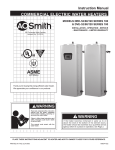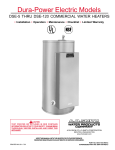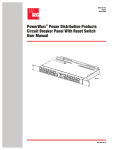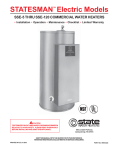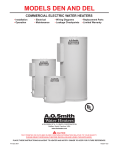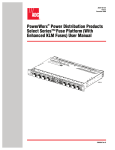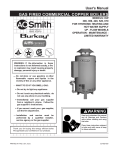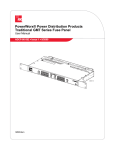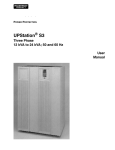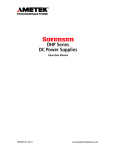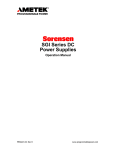Download A.O. Smith DVE Owner's Manual
Transcript
Models DRE & DVE - 52/80/120 COMMERCIAL ELECTRIC WATER HEATERS • INSTALLATION • OPERATION • MAINTENANCE • LIMITED WARRANTY CAUTION TEXT PRINTED OR UNDERLINED IN RED CONTAINS INFORMATION RELATIVE TO YOUR SAFETY. PLEASE READ THOROUGHLY BEFORE ATTEMPTING ANY CONVERSION. A DIVISION OF A.O. SMITH CORPORATION MCBEE, SOUTH CAROLINA www.hotwater.com PLACE THESE INSTRUCTIONS ADJACENT TO HEATER AND NOTIFY OWNER TO KEEP FOR FUTURE REFERENCE. PRINTED IN U.S.A. 0906 PART NO. 196674-001 1 Rough-in-Dimensions Model Number DRE/DVE-52 DRE/DVE-80 DRE/DVE-120 Tank Capacity in Gallons 50 80 119 A 55 1/4 59 1/2 62 1/4 Get to know your water heater 2 B 21 3/4 25 1/4 29 1/2 Inlet/Outlet 1 1/4 1 1/4 1 1/4 Contents Page Amperage Table/Overcurrent Protection ................. 16 Heater Circuits - DVE Models .................................. 16 Control Circuit .......................................................... 16-17 Power Circuit ............................................................ 18-21 OPERATION General .................................................................... 22 Filling ........................................................................ 22 Startup ...................................................................... 22 High Temperature Limiting Device ........................... 22 Draining .................................................................... 22 Circulating Pump ..................................................... 22 MAINTENANCE General .................................................................... 23 Flushing ................................................................... 23 Sediment Removal ................................................... 23 Lime Scale Removal ................................................ 23-24 Checklist .................................................................. 24 Replacement Parts .................................................. 24 LEAKAGE CHECKPOINTS ..................................... 25 LIMITED WARRANTY .............................................. 26 Page ROUGH-IN-DIMENSIONS ....................................... 2 GET TO KNOW YOUR WATER HEATER ............... 2 RECOVERY CAPACITY ........................................... 3 APPROVALS ............................................................ 3 MODEL AND RATING PLATE .................................. 4 FOREWORD ............................................................ 4 GENRAL SAFETY INFORMATION .......................... 4 INSTALLATION ........................................................ 5 Required Ability ........................................................ 5 General .................................................................... 5 Location ................................................................... 5 Waterline Connections ............................................. 5 Relief Devices .......................................................... 5-6 Temperature Limiting Control(s) .............................. 6 Temperature Regulation .......................................... 6 PIPING DIAGRAMS ................................................. 7-14 ELECTRICAL General .................................................................... 14 Branch Circuit .......................................................... 15 Recovery Rating RECOVERY RATE IN GALLONS PER HOUR* Temperature Rise °F Models DRE/DVE DRE/DVE DRE/DVE DRE/DVE DRE/DVE DRE/DVE DRE/DVE DRE/DVE DRE/DVE DRE/DVE DRE/DVE DRE/DVE DRE/DVE Standard KW Input 6 9 12 13.5 15 18 24 27 30 36 40.5 45 54 BTU/ Hour 20,478 30,717 40,956 46,075 51,195 61,434 81,912 92,151 102,390 122,868 138,226 153,585 184,302 30° 82 123 164 184 205 246 328 369 410 492 554 615 738 40° 62 92 123 138 154 184 246 276 307 369 418 461 553 50° 49 74 98 111 123 148 197 221 246 295 3332 369 443 60° 41 62 82 92 102 123 164 184 205 246 277 307 369 70° 35 53 70 79 88 105 140 158 176 211 237 263 316 80° 31 46 61 69 77 92 123 138 154 184 208 230 277 90° 27 41 55 62 68 82 109 123 137 164 185 205 246 100° 110° 25 22 37 34 49 45 55 50 61 56 74 67 98 89 111 101 123 112 148 134 166 151 184 168 221 201 *Figured at 1 KW (3413 Btu) = 4.1 gallons at 100°F temperature rise. To determine recovery rate per minute, divide recovery rate per hour by 60. Approvals All models bear the National Sanitation Foundation seal of approval. All models are listed by Underwriters Laboratories Inc. 3 120° 21 31 41 46 51 61 82 92 102 123 138 154 184 130° 19 28 38 43 47 57 76 85 95 113 128 142 170 140° 18 26 35 40 44 53 70 79 88 105 119 132 158 Model and Rating Foreword Detailed installation diagrams are in this manual. These diagrams will serve to provide the installer with a reference for the materials and method of piping suggested. IT IS NECESSARY THAT ALL WATER PIPING AND THE ELECTRICAL WIRING BE INSTALLED AND CONNECTED AS SHOWN IN THE DIAGRAMS. jurisdiction shall be consulted before installations are made. BE SURE TO TURN OFF POWER WHEN WORKING ON OR NEAR THE ELECTRICAL SYSTEM OF THE HEATER. NEVER TOUCH ELECTRICAL COMPONENTS WITH WET HANDS OR WHEN STANDING IN WATER. WHEN REPLACING FUSES ALWAYS USE THE CORRECT SIZE FOR THE CIRCUIT. SEE PAGE 16 THROUGH 21. Particular attention should be given to the installation of thermometers at the locations indicated in the diagrams as these are necessary for checking the operation of the heater. The principal components of the heater are identified on page 2. The model and rating plate on page 4 interprets certain markings into useful information. Both of these references should be used to identify the heater, its components and optional equipment. In addition to these instructions, the equipment shall be installed in accordance with those installation regulations in force in the local area where the installation is to be made. Authorities having General Safety Information that the hot water faucet be opened for several minutes at the kitchen sink before using any electrical appliance connected to the hot water system. If hydrogen is present there will probably be an unusual sound such as air escaping through the pipe as the water begins to flow. THERE SHOULD BE NO SMOKING OR OPEN FLAME NEAR THE FAUCET AT THE TIME IT IS OPEN. PRECAUTIONS DO NOT USE THIS APPLIANCE IF ANY PART HAS BEEN UNDER WATER. Immediately call a qualified service technician to inspect the appliance and to replace any part of the control system and any gas control which has been under water. INSULATION BLANKETS IF THE UNIT IS EXPOSED TO THE FOLLOWING, DO NOT OPERATE HEATER UNTIL ALL CORRECTIVE STEPS HAVE BEEN MADE BY A QUALIFIED SERVICEMAN. Insulation blankets available to the general public for external use on water heaters are not approved for use on your A.O. Smith water heater. The purpose of an insulation blanket is to reduce the standby heat loss encountered with storage tank water heaters. Your A.O. Smith water heater meets or exceeds the ASHRAE/IES 90.1b 1992 standards with respect to insulation and standby loss requirements, making an insulation blanket unnecessary. 1. EXTERNAL FIRE. 2. DAMAGE. 3. FIRING WITHOUT WATER. GROUNDING INSTRUCTIONS This water heater must be grounded in accordance with the National Electric Code and/or local codes. These must be followed in all cases. WARNING Should you choose to apply an insulation blanket to this heater, you should follow these instructions (See "Getting to know your water heater" on page 2 for identification of components mentioned below). Failure to follow these instructions can result in fire, asphyxiation, serious personal injury or death. This water heater must be connected to a grounded metal, permanent wiring system; or an equipment grounding conductor must be run with the circuit conductors and connected to the equipment grounding terminal or lead on the water heater. • Do not cover the temperature & pressure relief valve. • Do not cover the instruction manual. Keep it on the side of the water heater or nearby for future reference. • Do obtain new labels from A.O. Smith for placement on the blanket directly over the existing labels. HYDROGEN GAS (FLAMMABLE) CAUTION HYDROGEN GAS CAN BE PRODUCED IN A HOT WATER SYSTEM SERVED BY THIS HEATER THAT HAS NOT BEEN USED FOR A LONG PERIOD OF TIME (GENERALLY TWO WEEKS OR MORE). HYDROGEN GAS IS EXTREMELY FLAMMABLE. To reduce the risk of injury under these conditions, it is recommended WARNING FAILURE TO FOLLOW THESE INSTRUCTIONS CAN RESULT IN SERIOUS PERSONAL INJURY OR DEATH. 4 Installation REQUIRED ABILITY Locate the heater close to the point of major hot water usage and the power supply. • Try to make hot water piping and branch circuit wiring as short as possible. • Insulate hot and cold water piping where heat loss and condensation may be a problem. INSTALLATION OR SERVICE OF THIS WATER HEATER REQUIRES ABILITY EQUIVALENT TO THAT OF A LICENSED TRADESMAN IN THE FIELD INVOLVED. PLUMBING AND ELECTRICAL WORK ARE INVOLVED. GENERAL THE HEATER SHOULD NOT BE LOCATED IN AN AREA WHERE IT WILL BE SUBJECT TO FREEZING. The installation must conform to these instructions and the local code authority having jurisdiction. Grounding and electrical wiring connected to the water heater must also conform to the current version of the National Electrical Code NFPA-70 or for Canadian requirements the current version of the Canadian Electric Code, CAN/CSA-C22.2 No. M91. These codes may be obtained from the following institutes; The NFPA-70 is available from the National Fire Protection Association, 1 Batterymarch Park, Quincy, MA 02269. The CAN/CSA C22.2 No. M91 is available from the Canadian Standards Association, 178 Rexdale Blvd., Toronto Ontario, Canada M9W 1R3. Suggested clearances from adjacent surfaces are 18 inches in front for access to the controls and elements and 12 inches from top. The heater may be installed on or against combustible surfaces. WATER LINE CONNECTIONS This manual provides detailed installation diagrams (see back section of this manual) for typical methods of application for the water heaters. The water heater may be installed by itself, or with a separate storage tank, on both single and two-temperature systems. When used with a separate storage tank, the circulation may be either by gravity or by means of a circulating pump. When a circulating pump is used it is important to note that the flow rate should be slow so that there will be a minimum of turbulence inside the heater. If your location requires the installation of the water heater to comply with National Sanitation Foundation requirements, the heater must be sealed to the floor so as to prevent seepage underneath the heater. The following are recommended sealants that may be used on all types of flooring except concrete GE Silicone Seal RTV-120, 103, 108, and 109. LOCATION CAUTION A closed system will exist if a check valve, pressure reducing valve, or a water meter is installed in the cold water line between the water heater and street main (or well). For proper installation, the heater should be installed on a level surface. LOCATE THE WATER HEATER NEAR A FLOOR DRAIN. THE HEATER SHOULD BE LOCATED IN AN AREA WHERE LEAKAGE FROM THE HEATER OR CONNECTIONS WILL NOT RESULT IN DAMAGE TO THE ADJACENT AREA OR TO LOWER FLOORS OF THE STRUCTURE. Excessive pressure may develop causing premature tank failure or intermittent relief valve operation. This type of failure is not covered by the limited warranty. An expansion tank may be required in the inlet supply line between the appliance and the meter or valve to compensate for the thermal expansion of water. WHEN SUCH LOCATIONS CANNOT BE AVOIDED, A SUITABLE DRAIN PAN SHOULD BE INSTALLED UNDER THE HEATER. Such pans should be fabricated with sides at least 2" deep, with length and width at least 2" greater than the diameter of the heater and must be piped to an adequate drain. Drain pans suitable for these heaters are available from your distributor or Product Service Division, A.O. Smith Water Heater Parts Fulfillment, 125 Southeast Parkway, Franklin, TN 37068. If a water heater is installed in a closed water system, contact the water supplier or local plumbing inspector on how to control this situation. RELIEF DEVICES CAUTION TO REDUCE THE RISK OF EXCESSIVE PRESSURES AND TEMPERATURE IN THIS WATER HEATER, INSTALL TEMPERATURE AND PRESSURE PROTECTIVE EQUIPMENT REQUIRED BY LOCAL CODES but not less than a combination temperature and pressure relief valve certified by a nationally recognized testing laboratory that maintains periodic inspection of production of listed equipment or materials, as meeting the requirements for Relief Valves for Hot Water Supply Systems, ANSI Z21.22 /CSA 4.4 (current version). Water heater life depends upon water quality, water pressure and the environment in which the water heater is installed. Water heaters are sometimes installed in locations where leakage may result in property damage, even with the use of a drain pan piped to a drain. However, unanticipated damage can be reduced or prevented by a leak detector or water shut-off device used in conjunction with a piped drain pan. These devices are available from some plumbing supply wholesalers and retailers, and detect and react to leakage in various ways: This valve must be marked with a maximum set pressure not to exceed the marked maximum working pressure of the water heater. INSTALL THE VALVE INTO AN OPENING PROVIDED AND MARKED FOR THIS PURPOSE IN THE WATER HEATER, AND ORIENT IT OR PROVIDE TUBING SO THAT ANY DISCHARGE FROM THE VALVE WILL EXIST ONLY WITHIN 6 INCHES ABOVE, OR AT ANY DISTANCE BELOW THE STRUCTURAL FLOOR AND CANNOT CONTACT ANY LIVE ELECTRICAL PART. THIS DISCHARGE OPENING MUST NOT BE BLOCKED OR REDUCED IN SIZE UNDER ANY CIRCUMSTANCES. • Sensors mounted in the drain pan that trigger an alarm or turn off the incoming water to the water heater when leakage is detected. • Sensors mounted in the drain pan that turn off the water supply to the entire home when water is detected in the drain pan. • Water supply shut-off devices that activate based on the water pressure differential between the cold water and hot water pipes connected to the water heater. • Devices that will turn off the gas supply to a gas water heater while at the same time shutting off its water supply. 5 The pressure setting of the relief valve should not exceed the pressure capacity of any component in the system. The temperature setting of the relief valve should not exceed 210°F. SMALL CHILDREN TO USE A HOT WATER TAP, OR TO DRAW THEIR OWN BATH WATER. NEVER LEAVE A CHILD OR DISABLED PERSON UNATTENDED IN A BATHTUB OR SHOWER. An unplugged 3/4" relief valve opening is provided for installing temperature and pressure relief valve. THE WATER HEATER SHOULD BE LOCATED IN AN AREA WHERE THE GENERAL PUBLIC DOES NOT HAVE ACCESS TO SET TEMPERATURES. TEMPERATURE LIMITING CONTROL(S) SETTING THE WATER HEATER TEMPERATURES AT 120°F WILL REDUCE THE RISK OF SCALDS. Some states require settings at specific lower temperatures. Both the DVE and DRE model water heaters incorporate high temperature cutoffs. In the event of high temperature cutoff operation, the reason for the operation of the high temperature cutoff operation must be determined and corrected. Once the situation has been corrected the high temperature cutoff(s) may be reset in the following manner: The water temperature is controlled in the DVE models with a single thermostat located on the right front of the heater, just inside the control cabinet. This control is set at 140°F at the factory and has a fixed 5°F differential. The DRE models have multiple thermostats depending on the configuration purchased. These thermostats are also set at 140°F and have a 5-15°F differential. A.O. Smith recommends setting the dial at the lowest setting which produces an acceptable hot water supply. This will always give the most energy efficient operation. DVE Models The DVE models have a single immersion-type high temperature cutoff control in the control circuit, see DVE CONTROL CIRCUIT DIAGRAMS. This high temperature cutoff is factory set to open at 190°F (88°C). To manually reset the control you must: 1. 2. 3. 4. Disconnect the power to the heater. Allow the tank to cool to approximately 120°F. Remove the front control cover. Press the manual reset button. The control will not reset until it has cooled approximately 50°F (28°C). Figure 1 shows the approximate time-to-burn relationship for normal adult skin. Valves for reducing point-of-use temperature by mixing cold and hot water are available. Also available are inexpensive devices that attach to faucets to limit hot water temperatures. Contact a licensed plumber or the local plumbing authority. DRE Models The DRE models have multiple surface mounted combination high temperature cutoff and thermostat controls. There is one of these combination high temperature cutoff and thermostat controls for each element in a DRE model, see DRE CIRCUIT DIAGRAMS. Each of the high temperature controls is of the manual reset type. To manually reset the controls: 1. 2. 3. 4. Disconnect the power to the heater. Allow the tank to cool approximately 160°F. Remove the front control cover. Press the manual reset button on each of the effected controls. The control will not reset until it has cooled approximately 30°F (17°C). Once the control(s) has been reset the control cover should be replaced prior to operating the heater. TEMPERATURE REGULATION DRE MODELS Temperature Setting 180°F 170°F 160°F 150°F 140°F 130°F 120°F DANGER THIS WATER HEATER IS EQUIPPED WITH AN ADJUSTABLE THERMOSTAT TO CONTROL WATER TEMPERATURE. HOT WATER TEMPERATURES REQUIRED FOR AUTOMATIC DISHWASHER AND LAUNDRY USE CAN CAUSE SCALD BURNS RESULTING IN SERIOUS PERSONAL INJURY AND/OR DEATH. THE TEMPERATURE AT WHICH INJURY OCCURS VARIES WITH THE PERSONS AGE AND TIME OF EXPOSURE. THE SLOWER RESPONSE TIME OF CHILDREN, AGED, OR DISABLED PERSONS INCREASES THE HAZARDS TO THEM. NEVER ALLOW DVE MODELS Time to produce 2nd & 3rd Degree burns on adult skin Nearly instantaneous Nearly instantaneous About 1/2 second About 1-1/2 seconds Less than 5 seconds About 30 seconds More than 5 minutes FIGURE 1 6 Piping Diagrams ONE TEMPERATURE WITH CIRCULATING LOOP INSERT B VACUUM RELIEF VALVE. INSTALL PER LOCAL CODES. DANGER TEMPERATURE SETTING SHOULD NOT EXCEED SAFE TEMPERATURE AT FIXTURES. SEE WATER TEMPERATURE CONTROL WARNING ON PAGE 6. IF HIGHER PREHEAT TEMPERATURES ARE NECESSARY TO OBTAIN ADEQUATE BOOSTER OUTPUT, ADD AN ANTI-SCALD VALVE FOR HOT WATER SUPPLIED TO FIXTURES. CAUTION: IF BUILDING COLD WATER SUPPLY HAS A BACKFLOW PREVENTER, CHECK VALVE OR WATER METER WITH CHECK VALVE. PROVISIONS FOR THERMAL EXPANSION OF WATER IN THE HOT WATER SYSTEM MUST BE PROVIDED. *PIPE TO OPEN DRAIN INSTALL IN ACCORDANCE WITH ALL LOCAL CODES. 7 INSERT B DANGER TEMPERATURE SETTING SHOULD NOT EXCEED SAFE TEMPERATURE AT FIXTURES. SEE WATER TEMPERATURE CONTROL WARNING ON PAGE 6. IF HIGHER PREHEAT TEMPERATURES ARE NECESSARY TO OBTAIN ADEQUATE BOOSTER OUTPUT, ADD AN ANTI-SCALD VALVE FOR HOT WATER SUPPLIED TO FIXTURES. VACUUM RELIEF VALVE. INSTALL PER LOCAL CODES. 8 INSERT B DANGER TEMPERATURE SETTING SHOULD NOT EXCEED SAFE TEMPERATURE AT FIXTURES. SEE WATER TEMPERATURE CONTROL WARNING ON PAGE 6. IF HIGHER PREHEAT TEMPERATURES ARE NECESSARY TO OBTAIN ADEQUATE BOOSTER OUTPUT, ADD AN ANTI-SCALD VALVE FOR HOT WATER SUPPLIED TO FIXTURES. VACUUM RELIEF VALVE. INSTALL PER LOCAL CODES. 9 ONE TEMPERATURE ONE HEATER VERTICAL STORAGE TANK FORCED CIRCULATION WITHOUT BUILDING RECIRCULATION INSERT B VACUUM RELIEF VALVE. INSTALL PER LOCAL CODES. DANGER TEMPERATURE SETTING SHOULD NOT EXCEED SAFE TEMPERATURE AT FIXTURES. SEE WATER TEMPERATURE CONTROL WARNING ON PAGE 6. IF HIGHER PREHEAT TEMPERATURES ARE NECESSARY TO OBTAIN ADEQUATE BOOSTER OUTPUT, ADD AN ANTI-SCALD VALVE FOR HOT WATER SUPPLIED TO FIXTURES. TWO TEMPERATURE WITH MIXING VALVE AND CIRCULATING LOOP CAUTION: IF BUILDING COLD WATER SUPPLY HAS A BACK-FLOW PREVENTER, CHECK VALVE OR WATER METER WITH CHECK VALVE, PROVISIONS FOR THERMAL EXPANSION OF WATER IN THE HOT WATER SYSTEM MUST BE PROVIDED. *PIPE TO OPEN DRAIN INSTALL IN ACCORDANCE WITH ALL LOCAL CODES TWO TEMPERATURE WITH MIXING VALVE 10 DANGER INSERT B TEMPERATURE SETTING SHOULD NOT EXCEED SAFE TEMPERATURE AT FIXTURES. SEE WATER TEMPERATURE CONTROL WARNING ON PAGE 6. IF HIGHER PREHEAT TEMPERATURES ARE NECESSARY TO OBTAIN ADEQUATE BOOSTER OUTPUT, ADD AN ANTI-SCALD VALVE FOR HOT WATER SUPPLIED TO FIXTURES. VACUUM RELIEF VALVE. INSTALL PER LOCAL CODES. 11 DANGER TEMPERATURE SETTING SHOULD NOT EXCEED SAFE TEMPERATURE AT FIXTURES. SEE WATER TEMPERATURE CONTROL WARNING ON PAGE 6. IF HIGHER PREHEAT TEMPERATURES ARE NECESSARY TO OBTAIN ADEQUATE BOOSTER OUTPUT, ADD AN ANTI-SCALD VALVE FOR HOT WATER SUPPLIED TO FIXTURES. INSERT B VACUUM RELIEF VALVE. INSTALL PER LOCAL CODES. 12 DANGER TEMPERATURE SETTING SHOULD NOT EXCEED SAFE TEMPERATURE AT FIXTURES. SEE WATER TEMPERATURE CONTROL WARNING ON PAGE 6. IF HIGHER PREHEAT TEMPERATURES ARE NECESSARY TO OBTAIN ADEQUATE BOOSTER OUTPUT, ADD AN ANTI-SCALD VALVE FOR HOT WATER SUPPLIED TO FIXTURES. INSERT B VACUUM RELIEF VALVE. INSTALL PER LOCAL CODES. 13 MANIFOLD KITS ALL DIMENSIONS IN INCHES. TWO HEATERS Part Model Number DRE/DVE-52 9003429 DRE/DVE-80 9003429 DRE/DVE-120 9003429 Inlet and outlet size — 1 1/2 H 66 1/4 70 1/2 73 1/4 W 56 3/4 60 1/4 64 1/2 D A 27 1/4 13 1/4 31 1/4 9 3/4 35 3/4 5 1/2 THREE HEATERS Part Model Number DRE/DVE-52 9003430 DRE/DVE-80 9003430 DRE/DVE-120 9003430 Inlet and outlet size —2 1/2 H 66 1/4 70 1/2 73 1/4 W 91 3/4 95 1/4 99 1/2 D A 27 1/4 13 1/4 31 1/4 9 3/4 35 3/4 5 1/2 FOUR HEATERS Part Model Number DRE/DVE-52 9003431 DRE/DVE-80 9003431 DRE/DVE-120 9003431 Inlet and outlet size —2 1/2 H W D A 66 1/4 126 3/4 27 1/4 13 1/4 70 1/2 130 1/4 31 1/4 9 3/4 73 1/4 134 1/2 35 3/4 5 1/2 Electrical Check the heater model and rating plate information against the characteristics of the branch circuit electrical supply. DO NOT CONNECT THE HEATER TO AN IMPROPER SOURCE OF ELECTRICITY. Contact the heater supplier for conversion information if necessary. GENERAL The installation must conform to these instructions, the local code authority having jurisdiction, and the requirements of the power company. In the absence of codes requirements follow the current version of NFPA-70. The National Electrical Code which may be ordered from National Fire Protection Association, 1 Batterymarch Park, Quincy, MA 02269. Voltage applied to the heater should not vary more than +5% to 10% of the model and rating plate marking for satisfactory operation. WARNING AN ELECTRICAL GROUND IS REQUIRED TO REDUCE RISK OF ELECTRIC SHOCK OR POSSIBLE ELECTROCUTION. The water heater should be connected to a separate grounded branch circuit with overcurrent protection and disconnect switch. The water heater should be grounded in accordance with national and local codes. DO NOT ENERGIZE THE BRANCH CIRCUIT FOR ANY REASON BEFORE THE HEATER TANK IS FILLED WITH WATER. DOING SO WILL CAUSE THE HEATING ELEMENTS TO BURN OUT. The branch circuit is connected to the heater wiring through an opening provided on the heater. 14 BRANCH CIRCUIT The branch circuit wire and fuse size should be established through reference to the current version of the National Electrical Code or any other locally approved source in conjunction with the heater amperage rating. Branch circuit wires should have a temperature rating no less than 75°C. For convenience, portions of the wire size tables from the code are reproduced here. It is suggested the electrician size the branch circuit at 125% of the heater ampere rating and further increase wire size as necessary to compensate for voltage drop in long runs. Branch circuit voltage drop should not exceed 3% at the heater. TABLE 310-16. Allowable Ampacities of Insulated Conductors Not more than three conductors in raceway, cable, or earth (directly buried), based on ambient temperature of 30°C (86°F) Size 60°C (140°F) TYPES RUW, T TW, UF AWG MCM 18 16 14 12 10 8 6 4 3 2 1 0 00 000 0000 250 300 350 400 500 Ambient Temp. °C 31-40 41-50 51-60 61-70 71-80 .... .... 15 20 30 40 55 70 80 .82 .58 .... .... .... Temperature Rating of Conductor, See Table 310-13 85°C 90°C 60°C 75°C 85°C 90°C (185°F) (194°F) (140°F) (167°F) (185°F) (194°F) TYPES TYPES TYPES TYPES TYPES TYPES V, MI, TA, TBS, RUW, T RH, RHW, V, MI, TA, TBS, SA, AVB, TW, UF RUH, SA, AVB, SIS, +FEP, THW, SIS, +FEPB, THWN, +RHH, +RHH, XHHW, +THHN, +THHN, USE +XHHW* +XHHW* ALUMINUM OR COPPER-CLAD ALUMINUM .... 21 .... .... .... .... 22 22 .... .... .... .... 25 25 .... .... .... .... 30 30 15 15 25 25 40 40 25 25 30 30 50 50 30 40 40 40 70 70 40 50 55 55 90 90 55 65 70 70 105 105 65 75 80 80 120 120 75 90 95 95 140 140 100 110 110 155 155 120 125 125 185 185 135 145 145 210 210 1155 165 165 235 285 180 185 185 270 270 205 215 215 300 300 230 240 240 325 325 250 260 260 360 360 270 290 290 405 405 310 330 330 CORRECTION FACTORS For ambient temperatures over 30°C, multiply the ampacities shown above by the appropriate correction factor to determine the maximum allowable load current. .88 .90 .91 .82 .88 .90 .91 .75 .80 .82 .58 .75 .80 .82 .58 .67 .71 .... .58 .67 .71 .35 .52 .58 .... .35 .52 .58 .... .30 .41 .... .... .30 .41 75°C (167°F) TYPES FEPW, RH, RHW, RUH, THW THWN, XHHW, USE, ZW COPPER .... .... 15 20 30 45 65 85 100 115 130 150 175 200 230 255 285 310 335 380 Size AWG MCM .... .... .... 12 10 8 6 4 3 2 1 0 00 000 0000 250 300 350 400 500 Ambient Temp. °F 86-104 105-122 123-141 142-158 159-176 +The load current rating and the overcurrent protection for these conductors shall not exceed 15 amperes for 14 AWG, 20 amperes for 12 AWG, and 30 amperes for 10 AWG copper; or 15 amperes for 12 AWG and 25 amperes for 10 AWG aluminum and copper-clad aluminum. *For dry locations only. See 75°C column for wet locations. 15 KW Number of Input Elements 6 9 12 3 13.5 15 18 18 24 27 6 30 36 36 40.5 9 45 54 Element Wattage 2000 3000 4000 4500 5000 6000 3000 4000 4500 5000 6000 4000 4500 5000 6000 208V 28.8 43.3 57.7 64.9 72.1 --86.5 115.4 129.8 144.2 --173.1 194.7 216.3 --- Full Load Current in Amperes Single Phase Three Phase 240V 277V 480V 208V 240V 25.0 21.7 12.5 16.7 14.4 37.5 32.5 18.8 25.0 21.7 50.0 43.3 25.0 33.3 28.9 56.3 48.7 28.1 37.5 32.5 62.5 54.2 31.3 41.6 36.1 75.0 65.0 37.5 --43.3 ------50.0 --100.0 86.6 50.0 66.6 57.7 112.5 97.5 56.3 74.9 65.0 125.0 108.3 62.5 83.3 72.2 150.0 130.0 75.0 --86.6 ------99.9 --168.8 146.2 84.4 112.4 108.3 187.5 162.5 93.8 124.9 108.3 225.0 194.9 112.5 149.9 129.9 The table above provides the total connected heating element load in amperes for branch circuit conductor and overcurrent protection sizing. Single-phase heaters are two wire circuits. Three-phase heaters are three wire circuits. In addition to the foregoing, a grounded conductor is required. 6 6 12 9 18* • Simultaneous element operation where all of the heating elements are operated by one thermostat. This is the standard circuit and may be used with up to nine elements. • Sequenced element operation where each row of three elements are operated by its own thermostat. This is an optional circuit and may be used with six or nine elements. The control circuit is operated on single-phase 120V current obtained from the control transformer or as shown in the wiring diagram. The water heater's electrical components are pictured and identified on page 2. The model and rating plate illustration on page 4 identifies heater circuit ratings. The DVE model has two electrical circuits. The power circuit, which is operated by the control circuit carries the electrical load of the heating elements. 3 The heater is equipped with one of the following 120V control circuits, resulting in: HEATER CIRCUITS - DVE MODELS • No. of Fuses CONTROL CIRCUIT - DVE MODELS The rating of the overcurrent protection must be computed on the basis of 125% of the total connected load amperage. Where the standard ratings and settings do not correspond with this computation, the next higher standard rating or setting should be selected. The control circuit, where the thermostat directly operates the contactor coils. No. of Thermostats The following describes the heater circuits and includes wiring diagrams. All heater circuits are designed for 50/60 cycle alternating current. AMPERAGE TABLE/OVERCURRENT PROTECTION • 480V 7.2 10.8 14.4 16.2 18.0 21.7 --18.9 32.5 36.1 43.3 --54.1 54.1 65.0 Beginning at the fuse block, control circuit wiring is 14 Awg, AWM (Appliance wiring material) type, rated 600 volts, 105°C. Standard equipment includes control circuit fusing using two, 3 amp, class G fuses with 600 volt rating. Do not substitute fuses of a different rating. TRANSFORMER CONNECTION TABLES NOTE: THIS TABLE TO BE USED FOR 8 TAP AND 5 TAP TRANSFORMERS VOLTS 208 240 277 480 16 LINE ON COMMON & 208 COMMON & 240 COMMON & 277 COMMON & 480 LOAD ON SECONDARY 120V DVE CONTROL CIRCUIT DIAGRAMS 17 DVE POWER CIRCUIT DIAGRAMS POWER CIRCUIT The power circuit wiring is 12 Awg. AWM or TEW type, rated 600 volts, 105°C. Power circuit fusing consists of three 30 amp class G fuses for each contactor. See wiring diagrams. Do not substitute fuses of a different rating. THREE ELEMENTS - SINGLE AND THREE PHASE SIX ELEMENTS - SINGLE AND THREE PHASE 18 DVE POWER CIRCUIT DIAGRAMS (Continued) NINE ELEMENTS - SINGLE AND THREE PHASE CONVERSION TO SINGLE PHASE CONVERSION TO THREE PHASE When the heater is shipped for connection to a three-phase electrical service, it may be connected to a single-phase electrical service of the same voltage by: When heater is shipped for connection to a single-phase electrical service, it may be connected to a three-phase electrical service of the same voltage by: 1. Disconnect blue wires and yellow wires from terminal L3. 1. Disconnect blue wires from terminal L1. 2. Reconnect all blue wires to terminal L1 (with black wires). 2. Disconnect yellow wires from terminal L2. 3. Reconnect all yellow wires to terminal L2 (with red wires). 3. Reconnect all blue wires and yellow wires to terminal L3. 4. Connect incoming power to terminals L1 and L2. 4. Connect incoming power to terminals L1, L2, and L3. 19 DRE POWER CIRCUIT DIAGRAMS HEATER CIRCUITS—DRE MODELS The water heater's electrical components are pictured and identified on page 2. The following describes the heater circuits and includes wiring diagrams. All heater circuits are designed for 60/50 hertz alternating current. The DRE circuit wiring is 12 AWG, AWM, or TEW type, rated 600 volts, 105°C. FUSING Fusing consists of two 30 amp class G fuses for each element. See wiring diagrams. Do not substitute fuses of a different rating. THREE ELEMENTS - SINGLE AND THREE PHASE SIX ELEMENTS - SINGLE AND THREE PHASE 20 DRE POWER CIRCUIT DIAGRAMS NINE ELEMENTS - SINGLE AND THREE PHASE CONVERSION TO SINGLE PHASE CONVERSION TO THREE PHASE When the heater is shipped for connection to a three-phase electrical service, it may be connected to a single-phase electrical service of the same voltage by: When heater is shipped for connection to a single-phase electrical service, it may be connected to a three-phase electrical service of the same voltage by: 1. Disconnect blue wires and yellow wires from terminal L3. 1. Disconnect blue wires from terminal L1. 2. Reconnect all blue wires to terminal L1 (with black wires). 2. Disconnect yellow wires from terminal L2. 3. Reconnect all yellow wires to terminal L2 (with red wires). 3. Reconnect all blue wires and yellow wires to terminal L3. 4. Connect incoming power to terminals L1 and L2. 4. Connect incoming power to terminals L1, L2, and L3. 21 Operation GENERAL • Never turn on power to the water heater without being certain the water heater is filled with water, and a temperature and pressure relief valve is installed in the relief valve opening. Thermostat operation may be checked by (a) manually operating thermostat(s) and (b) allowing the heater to come up to temperature and shut off automatically. 6. Close the front panel. DO NOT TEST ELECTRICAL SYSTEM BEFORE HEATER IS FILLED WITH WATER. FOLLOW FILLING AND START-UP INSTRUCTIONS IN OPERATION SECTION. HIGH TEMPERATURE LIMITING DEVICE The heater control circuit contains a high temperature cutoff switch. This device automatically shuts off the heating elements if excessive water temperatures, near the steam point, are reached. The high temperature cutoff contacts open at 190°F and must be manually reset (after a 30°F drop in water temperature). FILLING 1. Turn off the electrical disconnect switch. 2. Close the water heater drain valve by turning hand wheel to right (clockwise). DRAINING 3. Open a nearby hot water faucet to permit the air in the system to escape. The water heater must be drained if it is to be shut down and exposed to freezing temperatures. Maintenance and service procedures may also require draining the heater. 4. Fully open the cold water inlet pipe valve allowing the heater and piping to be filled. 1. Turn off the electrical disconnect switch. 5. Close the hot water faucet as water starts to flow. The heater is now ready for STARTUP and TEMPERATURE REGULATION. 2. Close the supply water inlet valve to heater. 3. Attach hose to outlet opening of drain valve and direct end to drain. STARTUP The following checks should be made by the installer when the heater is placed into operation for the first time. 4. Open a nearby hot water faucet and the heater drain valve. 5. If the heater is being drained for an extended shutdown, it is suggested the drain valve be left open during this period. The hose may be removed. 1. Turn off the electrical disconnect switch. 2. Open the front panel, check all water and electrical connections for tightness. Also check connections on top and side of heater. • • Repair water leaks and tighten electrical connections as necessary. Follow FILLING instructions when restoring hot water service. CIRCULATING PUMP 3. Depress red button on manual reset high limit switches. Where the water heating system includes a field installed circulating pump, it must be lubricated before being operated. The tube of lubricant supplied with the pump includes directions for use. 4. Turn on the electrical disconnect switch. 5. Observe the operation of the electrical components during the first heating cycle. Use care as the electrical circuits are energized. The circulating pump should be of all bronze construction. Maintenance Water heater maintenance includes periodic tank flushing and cleaning, and removal of lime scale from the heating element. GENERAL Periodically the drain valve should be opened and the water allowed to run until it flows clean. This will help to prevent sediment buildup in the tank bottom. The heater tank is equipped with an anode rod to aid in corrosion control. Periodically check the temperature and pressure relief valve to ensure that it is in operating condition. Lift the lever at the top of the valve several times until the valve seats properly and operates freely. Anode inspection must be performed periodically based on experience (or at least annually) to check the rod diameter and determine if replacement is necessary. The anode is initially about 13/16" to 7/8" diameter with an approximate 1/8" diameter wire in the center of the rod. The anode should be replaced when the 1/8" diameter wire is visible as it has been expended in the control of corrosion. Your dealer should be contacted for anode inspection. CAUTION THE WATER PASSING OUT OF THE VALVE DURING THIS CHECKING OPERATION MAY BE EXTREMELY HOT. 22 Lime scale accumulations may cause noises to occur during operation. MAINTENANCE SCHEDULE Component Tank Operation Flushing Interval Periodically Elements Lime Scale Removal As needed Anode Inspect As needed Required It is recommended that a heating element be removed periodically for examination. If it is scaled, all of the elements should be removed and cleaned. If the tank bottom has an accumulation of sediment it should be cleaned. Un•Lime ® delimer & element gaskets, Part Lime scale should be removed by dissolving the accumulation in UN•LIME® delimer. UN•LIME is a non-muriatic delimer, available from Product Service Division, A.O. Smith Water Heater Parts Fulfillment, 125 Southeast Parkway, Franklin, TN 37068. Do not use muriatic or hydrochloric acid base deliming solutions to remove lime scale from the elements. Tank flushing should be performed in accordance with the above schedule. Tank sediment removal and element lime scale removal must be performed as needed as determined by periodic inspection. Following are the instructions for performing recommended maintenance. Replacement gaskets, part no. 9000308, should be available at this time. FLUSHING 1. Turn off electrical disconnect switch. 2. Drain the heater following DRAINING instructions. The water heater drain valve should be opened periodically to help prevent sediment buildup on the tank bottom. 3. Open front panel. 1. Turn off the electrical disconnect switch. 4. Disconnect the element wiring. Try not to disturb the wiring unnecessarily and reconnection will be easier. 2. Attach hose to outlet opening of drain valve and direct end to drain. 5. Unscrew each element. • Open the drain valve by turning the hand wheel to the left (counterclockwise). Allow water to flow until it runs clean. 6. Remove the elements and gaskets from the openings. • Use a twisting, pulling action to remove elements scaled beyond the size of the tank openings. 3. When finished flushing: • Brush loose scale from elements. • Close heater drain valve and remove hose. 7. Lime scale removal: • Turn on electricity. • • If water does not flow from opened drain valve, follow instructions for sediment removal. SEDIMENT REMOVAL Place limed ends of heating elements into UN•LIME delimer and allow scale to dissolve. Do not permit delimer or water to contact heating element electrical terminals. Other scale removal: Water borne impurities consist of fine particles of soil and sand which settle out and form a layer of sediment on the bottom of the tank. In time, if not removed, the level of sediment might reach the heating elements and cause their failure. • For convenience, sediment removal and element lime scale removal should be performed at the same time as follows. Silicates, sulfates, and aluminates must be removed by scraping or other mechanical means. Lime scale dissolvents will not remove these types of scale which are occasionally encountered. 8. Flush cleaned ends of elements with water when deliming or cleaning is completed. LIME SCALE REMOVAL 9. Remove sediment and scale from the tank bottom through the access provided by the element openings or drain valve opening. Lime scale accumulations on the heating elements is a normal condition, common to all immersion type elements. Factors which affect the amounts of this formation are: • 1. Amount of hot water used. As the volume of water heated increases, more scale results. The cold water inlet valve and drain valve may be opened to aid the cleanout process. 10. Clean remaining gasket material from tank and element flanges. Do not reuse original element gaskets. 2. Water temperature. As the temperature of the water is increased, more scale is deposited on the elements. 11. Put new gaskets on each element and install into tank openings. 3. Characteristics of water supply. • Regardless of water treatment, the elements should be examined regularly. 23 Uniformly tighten element bolts. Torque to approximately 32 ft./lbs. 12. Attach element wires to connection points from which they were removed. 2. Some of the electrical components of the water heater make sounds which are normal. 13. Follow FILLING instructions to restore hot water service. • Contactors will "click" or snap as the heater starts and stops. • Transformers and contacts often hum. • Check for water leaks around elements and proper operation when heater is filled. • Close the front panel. Water leakage is suspected Refer to Leakage Checkpoint of following page. CHECKLIST 1. Check to see if the heater drain valve is tightly closed. Before calling for service, check the following points to see if the cause of trouble can be identified and corrected. 2. If the outlet of the relief valve is leaking it may represent: Reviewing this checklist may eliminate the need of a service call and quickly restore hot water service. The illustration on page 2 identifies the location of all of the heater components. BE SURE TO TURN OFF THE ELECTRICITY WHEN CHECKING EQUIPMENT. 1. Be certain the electrical disconnect switch serving the water heater is in the ON position. • The heater has fusing. 3. If the water was excessively hot, and is now cold, the high limit switch may have operated. • To reset, open the front panel and push the reset button. • Repeated operation of the high temperature cutoff should be investigated by your dealer. Faulty relief valve. • Excessive water pressure. • Installation of a second relief valve set lower than the primary safety relief valve. • An expansion tank of suitable pressure and provision to avoid water logging. • Removal of the check valve. 4. Examine the area around the element for gasket leakage. • 4. The capacity of the heater may have been exceeded by a large demand for hot water. • • When such a condition is encountered, local codes or inspection agency should be consulted to determine which system is acceptable in your area. These may consist of: 2. Check the fuses. The electrical disconnect switch usually contains fuses. Excessive water temperature. 3. Excessive water pressure is the most common cause of relief valve leakage. It is often caused by a "closed system." A check valve in the inlet system will not permit the expanded hot water volume to equalize pressure with the main. A relief valve must release this water or the water heater or plumbing system will be damaged. Not enough or no hot water • • Large demands require a recovery period to restore water temperature. Tighten the elements or, if necessary, follow the WATER AND LIME SCALE REMOVAL procedure to replace the gaskets. IF YOU CANNOT IDENTIFY OR CORRECT THE SOURCE OF MALFUNCTION 5. Cooler incoming water temperature will lengthen the time required to heat water to the desired temperature. 1. Place the water heater electrical switch in the OFF position. 6. Look for hot water leakage. 2. Close the supply water inlet valve to the heater. 7. Sediment or pipe scale may be affecting water heater operation. Refer to page 23 for details. 3. Contact your dealer. REPLACEMENT PARTS Water is too hot Replacement parts may be ordered through dealers, authorized servicers, or distributors. Refer to Yellow Pages for where to call or contact the Product Service Division, A.O. Smith Water Heater Parts Fulfillment,125 Southeast Parkway, Franklin, TN 37068, 1800-433-2545. When ordering parts, specify complete model no., serial no., (see rating plate), quantity and name of part desired. Standard hardware items should be purchased locally. 1. Sediment or lime scale accumulations on the elements causes sizzling and hissing noises when the heater is operating. • The sounds are normal, however, the tank bottom and elements should be cleaned. Refer to page 23 for details. 24 Leakage Checkpoints INSTRUCTIONS: USE THIS ILLUSTRATION AS A GUIDE WHEN CHECKING FOR SOURCES OF WATER LEAKAGE. YOU OR YOUR DEALER MAY BE ABLE TO CORRECT WHAT APPEARS TO BE A PROBLEM. Where possible, remove or lift top cover to examine threads of fittings installed into tank for evidence of leakage. Correct fitting leaks as necessary. Relief valve operation and leakage may be due to water expansion during heating cycle or foreign material on seat of valve. If the valve is not piped to an open drain, the released water could be mistaken for a leaking heater. To check where threaded portion enters tank, insert Q-tip or similar absorbent material between jacket opening and valve to swab spud area. Remove valve* if leak is indicated and repair with pipe joint compound. Water on the side of the tank may be condensation due to the panel or insulation not being in place. Water leaks at the elements may be due to: 1. Defective elements which leak at terminals or through flange. Replace element*. 2. Loose element/gasket leak: Tighten element with element wrench. If leak continues, remove element* and discard gasket. Clean gasket seating areas and reinstall element with new gasket. Condensation and dripping may appear on pipes when inlet water temperature is low. Pipe fitting may be leaking. Drain valve leakage could be from the valve itself. Either correct the problem or replace the valve*. To check for leakage where threaded portion enters tank, insert Q-tip or similar absorbent material between jacket opening and valve to swab spud area. Remove valve* if leak is indicated and repair with pipe joint compound. * All water which appears at the heater bottom or on the surrounding floor may be caused by condensation, loose connections or relief valve operation and leakage. Do not replace the heater until a full inspection of all potential leak points is made and corrective steps taken to stop the leak. Leakage from other appliances, water lines, or ground seepage should also be suspected until proved otherwise. Contact your dealer as it is necessary to shut off electricity and drain tank to perform procedure. 25 Limited Warranty A. O. Smith Corporation, the warrantor, extends the following LIMITED WARRANTY to the owner of this water heater: 1. THE TANK If the glass-lined tank in this water heater shall prove upon examination by the warrantor to have leaked due to natural corrosion from potable watertherein, during the first THREE years after initial installation, the warrantor will supply a complete new A. O. Smith water heater of equivalent size and current model. Some government agencies are requiring energy efficient standards for water heaters. In the event regulations prohibit sale of a model of equivalent size and construction, A. O. Smith will provide a model which complies with the regulations of your area, in which case the consumer will be charged the difference in price between the like replacement and the energy efficient model required. The warranty on the replacement water heater will be limited to the unexpired term of the original warranty. 2. ALL OTHER PARTS If within ONE year after initial installation of this water heater, any part or portion shall prove upon examination by the warrantor to be defective in material or workmanship, the warrantor will repair or replace such part or portion at its option. 3. CONDITIONS and EXCEPTIONS This warranty shall apply only when the water heater is installed in accordance with local plumbing and building codes, ordinances and regulations, the printed instructions provided with it and good industry practices. In addition, a temperature and pressure relief valve, certified by A.G.A.and approved by the American Society of Mechanical Engineers, must have been installed. a. This warranty shall apply only when the heater is used: (1) at temperatures not exceeding the maximum setting of its thermostat; (2) at water pressure not exceeding the working pressure shown on the water heater; (3) when filled with potable water, free to circulate at all times; (4) in a noncorrosive and non-contaminated atmosphere; (5) in the United States, its territories or possessions, and Canada. (6) used with factory approved anode(s) installed; (7) in its original installation location; (8) sized in accordance with proper sizing techniques for commercial water heaters; (9) bearing a rating plate which has not been altered, defaced or removed except as required by the warrantor; (10) not used in a closed system without a properly sized and installed thermal expansion tank; (11) fired at the proper voltage and wattage; (12) maintained in accordance with the instructions printed in the manual included with the heater. b. Any accident to the water heater, any misuse, abuse (including freezing) or alteration of it, any operation of it in a modified form, or any attempt to repair tank leaks will void this warranty. 4. SERVICE and REPAIR EXPENSE Under this limited warranty the warrantor will provide only a replacement water heater or part thereof. The owner is responsible for all other costs. Such costs may include but are not limited to: a. Labor charges for service, removal, repair, or reinstallation of the water heater or any component part; b. Shipping, delivery, handling, and administrative charges for forwarding the new heater or replacement part from the nearest distributor and returning the claimed defective heater or part to such distributor; c. All cost necessary or incidental for any materials and/or permits required for installation of the replacement heater or part. 5. LIMITATIONS ON IMPLIED WARRANTIES Implied warranties, including any warranty of merchantability imposed on the sale of this heater under state law are limited to one (1) year duration for the heater or any of its parts. Some states do not allow limitations on how long an implied warranty lasts, so the above limitation may not apply to you. 6. CLAIM PROCEDURE Any claim under this warranty should be initiated with the dealer who sold the heater, or with any other dealer handling the warrantor’s products. If this is not practicable, the owner should contact: U.S. Customers A. O. Smith Water Products Company 500 Tennessee Waltz Parkway Ashland City, TN 37015 Telephone: 1-800-323-2636 a. b. 7. Canadian Customers A. O. Smith Enterprises, Ltd. P. O. Box 310 - 768 Erie Street Stratford, Ontario N5A 6T3 Telephone: 1-800-265-8520 The warrantor will only honor replacement with identical or similar water heater or parts thereof which are manufactured or distributed by the warrantor. Dealer replacements are made subject to in-warranty validation by warrantor. DISCLAIMERS NO OTHER EXPRESS WARRANTY HAS BEEN OR WILL BE MADE IN BEHALF OF THE WARRANTOR WITH RESPECT TO THE MERCHANTABILITY OF THE HEATER OR THE INSTALLATION, OPERATION, REPAIR, OR REPLACEMENT OF THE HEATER. THE WARRANTOR SHALL NOT BE RESPONSIBLE FOR WATER DAMAGE, LOSS OF USE OF THE UNIT, INCONVENIENCE, LOSS OR DAMAGE TO PERSONAL PROPERTY, OR OTHER CONSEQUENTIAL DAMAGE. THE WARRANTOR SHALL NOT BE LIABLE BY VIRTUE OF THIS WARRANTY OR OTHERWISE FOR DAMAGE TO ANY PERSONS OR PROPERTY, WHETHER DIRECT OR INDIRECT, AND WHETHER ARISING IN CONTRACT OR IN TORT. a. b. Some states do not allow the exclusion or limitation of the incidental or consequential damage, so the above limitation or exclusion may not apply to you. This warranty gives you specific legal rights, and you may also have other rights which vary from state to state. Fill in the following for your own reference. Keep it. Registration is not a condition of warranty. The model and serial number are found on the heater’s rating plate. Model No.________________________________________ Serial No.________________________________ Date Installed ________________ Dealer’s Name_________________________________________________________________________________________________________ Dealer’s Address _______________________________________________________________________Phone No. _______________________ City and State __________________________________________________________________________Zip ____________________________ 26 27 McBee, South Carolina 29101 Phone: 1-800-527-1953 Fax: 800-433-2515 www.hotwater.com e-mail: [email protected] 28





























